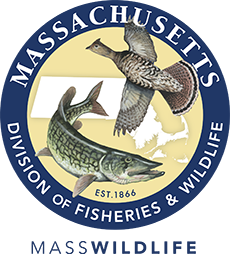- Division of Fisheries and Wildlife
Media Contact
Media Contact, MassWildlife

The Quinapoxet Dam on the lower Quinapoxet River in West Boylston will be removed to restore natural fish passage, enhance recreational opportunities, and improve aquatic habitats. To prepare for the removal, slated to begin this fall, MassWildlife worked with the Department of Conservation and Recreation (DCR) and the Division of Ecological Restoration (DER) to protect freshwater mussels from short-term impacts of the project by relocating mussels upstream.
Freshwater mussels spend most of their lives filter feeding on stream and river bottoms and only travel a few feet throughout their entire adulthood. While dam removal projects are carefully planned to minimize and mitigate impacts to aquatic habitats, disturbance of the streambed is unavoidable. The Quinapoxet Dam removal project includes reconstruction of the stream bottom that mussels would not be able to survive because of their limited mobility.
The relocation efforts were focused on eastern pearlshell mussels (Margaritifera margaritifera, also known as freshwater pearl mussels) that are found near the dam removal site. Although eastern pearlshells are thriving in the Quinapoxet, all freshwater mussels in the Northeast face a variety of serious threats. Protecting this healthy population of mussels is a vital part of conservation efforts in Massachusetts and across the region.
In early September, dozens of volunteers joined staff from MassWildlife, DCR, and DER to move eastern pearlshells from areas near the dam to select areas upstream in the Quinapoxet River. Using view buckets (5-gallon buckets with Plexiglass bottoms), masks and snorkels, and keen eyes, the group searched approximately 500 linear feet of stream. Mussels were counted, placed in mesh bags, transported in coolers, and carefully placed in suitable habitat along a 1,000-foot stretch of river. In total, 1,636 eastern pearlshells of various sizes (0.75–4 inches) were moved to safety. To estimate the success of the effort, MassWildlife tagged 100 of the relocated mussels and will survey the river over the next several years.
The 250-foot-long, 18-foot-high Quinapoxet Dam was built in 1905 and is now obsolete. Dam removals like this one benefit a variety of aquatic animals and habitats and helps build resilience against future stressors in the watershed. Relatively small actions like relocating and monitoring the eastern pearlshell population in the Quinapoxet can make a big difference to mussel conservation in the region. The eastern pearlshell is considered a Species of Greatest Conservation Need in Massachusetts and in the region and is globally considered endangered by the IUCN Red List.
Freshwater mussels are a vital part of aquatic systems. As filter feeders, they remove algae, bacteria, and fungi from the water. They also cycle nutrients and provide food for other invertebrates and fish. Unfortunately, freshwater mussels are one of the most imperiled groups of animals in North America. Of the 12 freshwater mussel species in Massachusetts, 6 are listed under the Massachusetts Endangered Species Act. Historical and ongoing degradation of habitat, water quality, water quantity, and inaccessibility to fish hosts caused by human activities (e.g., climate change, water extraction, dams, development) threaten the Commonwealth’s freshwater mussels.
Learn more about freshwater mussels


